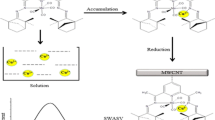Summary
Coulometry is a very useful technique for ultramicroanalysis, particularly when suitable titrants and methods of end-point detection are available. The choice of method for end-point detection must depend on consideration of (a) the precision required and (b) the feasibility of the method with small volumes of solution. The best method is one which will give correct results when used with a microcell of simple design; amperometric detection with two metallic electrodes meets these requirements. The choice of a titrant depends to some extent on the same criteria as the choice of a titrant for a macrotitration, but for ultramicro work certain criteria (such as solubility of reaction products, rate of reaction) are relatively more important. Complexones make useful titrants for many cations, and can be used in coulometric ultramicro titrations to determine 10−10–10−7 g of metal in 3–5μl of solution. Generally, the more complex the complexone used, the greater the sensitivity of the titration. For example, if DTPA (diethylenetriaminepentaacetic acid) is used instead of EDTA, the limit for detection of zinc is lowered by 1–2 orders of magnitude. By use of suitable complexones and masking agents, elements can be determined in the presence of each other. For example, zinc can be determined by coulometric ultramicrotitration (with electrogenerated DTPA) at particular points on the surface of the semiconductor material ZnSb without separation of antimony. The same titrant can be used for the determination of zinc in the presence of cadmium if the latter is masked withβ-dithiocarbaminopropionic acid.
Zusammenfassung
Die Coulometrie eignet sich sehr gut für die Ultramikroanalyse, besonders wenn geeignete Maßflüssigkeiten und Methoden zur Endpunktermittlung zur Verfügung stehen. Die Wahl dieser Methoden ist abhängiga) von der erforderlichen Genauigkeit und b) von der Durchführbarkeit mit kleinen Lösungsmengen. Am besten ist jene Methode, die bei Verwendung eines einfachen Mikrogefäßes genaue Resultate liefert; die amperometrische Bestimmung mit zwei metallischen Elektroden entspricht diesen Anforderungen. Die Wahl des Titrationsmittels hängt zum Teil von denselben Kriterien ab wie bei Makrotitrationen, aber für ultramikroanalytische Zwecke sind manche Kriterien (Löslichkeit der Reaktionsprodukte, Reaktionsgeschwindigkeit) besonders wichtig. Komplexone eignen sich für die Titration vieler Kationen; man kann damit durch Ultramikro-Coulometrie 10−10 bis 10−7 g Metall in 3–5μl Lösung bestimmen. Im allgemeinen ist die Empfindlichkeit der Titration um so größer, je komplizierter das Komplexon gebaut ist. Wenn man z. B. anstelle von ÄDTA Diäthylentriaminpentaacetat (DTPA) verwendet, wird die Nachweisgrenze für Zink um 1–2 Größenordnungen herabgesetzt. Verwendet man geeignete Komplexone und Maskierungsmittel, so lassen sich die Elemente in Gegenwart anderer Elemente bestimmen. Zum Beispiel kann man Zink durch coulometrische Ultramikrotitration mit elektrogeneriertem DTPA an bestimmten Punkten der Oberfläche des Halbleiters ZnSb ohne Abtrennung des Antimons bestimmen. Das gleiche Titrationsmittel kann für die Bestimmung von Zink in Gegenwart von Cadmium dienen, wenn man dieses mitβ-Dithiocarbaminopropionsäure maskiert.
Similar content being viewed by others
References
E. Bishop, Comprehensive Analytical Chemistry, Vol. 2D, Coulometric Analysis, eds. C. L. Wilson and D. W. Wilson. Amsterdam: Elsevier. 1975.
I. P. Alimarin and M. N. Petrikova, Qualitative and Quantitative Ultramicrochemical Analysis. Moscow: Khimiya. 1974.
International Review of Sciences: Analytical Chemistry, Part 2, ed. T. S. West, London: Butterworths. 1976. p. 187.
C. Reilley and W. Porterfield, Analyt. Chemistry28, 443 (1956).
T. A. Kokina, M. N. Petrikova and I. P. Alimarin, Zh. Analit. Khim.32, 1936 (1977).
O. Budevsky, E. Russeva, and B. Mesrob, Talanta13, 277 (1966).
E. Russeva and O. Budevsky, Talanta20, 1329 (1973).
Author information
Authors and Affiliations
Rights and permissions
About this article
Cite this article
Alimarin, I.P., Petrikova, M.N. & Kokina, T.A. Coulometric titration with complexones in inorganic ultramicro analysis. Mikrochim Acta 70, 1–8 (1978). https://doi.org/10.1007/BF01196463
Received:
Issue Date:
DOI: https://doi.org/10.1007/BF01196463




